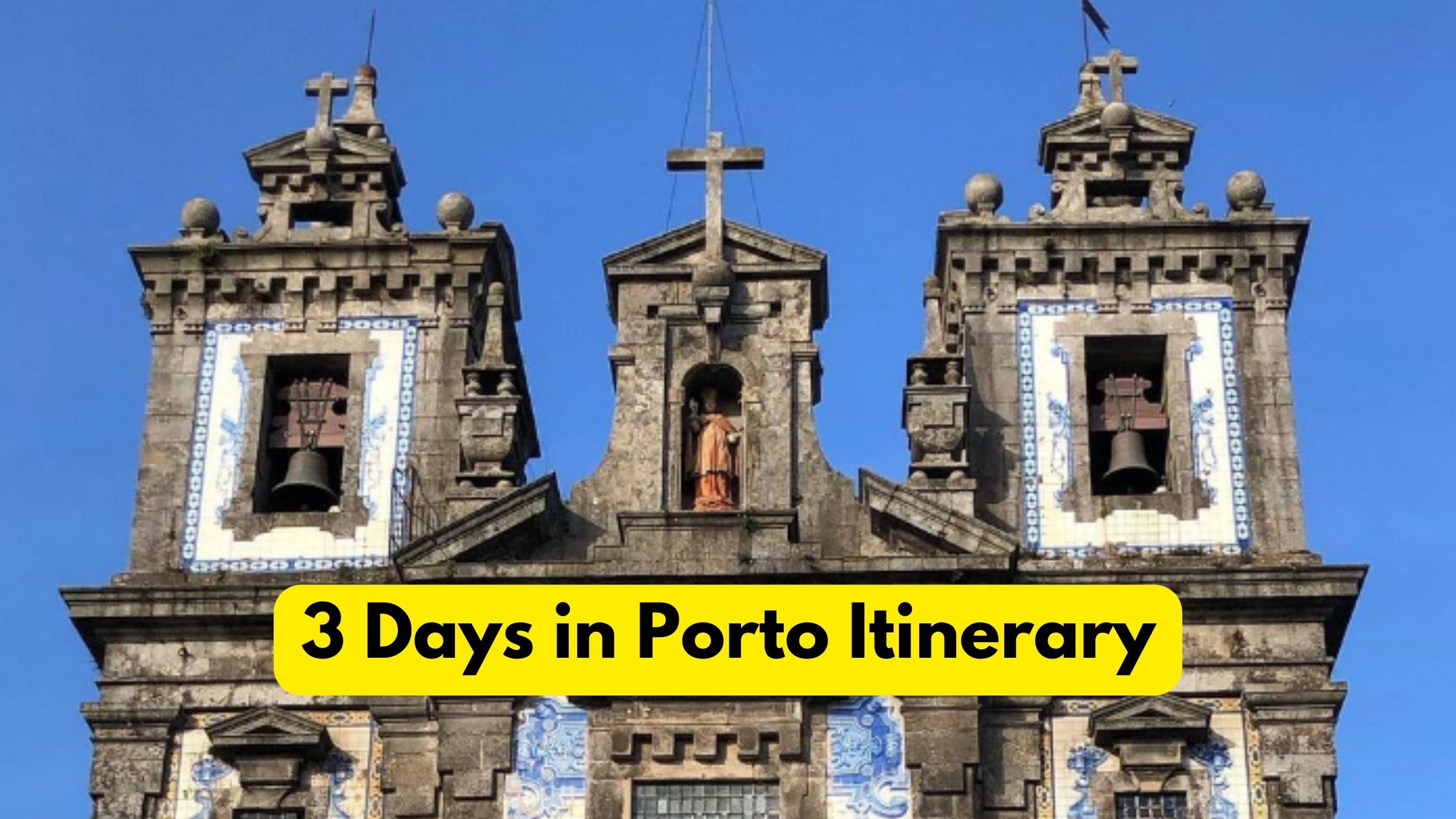How to Spend Three Days in Porto, Portugal – This article provides a detailed 3 Day itinerary for visiting Porto. It includes recommendations for activities, lodging, and timing. Find everything you need to plan your trip in the sections below.
Porto is a Charming City that distinguishes itself from Lisbon and the Algarve with a unique contrast that becomes apparent as soon as you step off the train. During the walking tour we took (this one, if you’re interested, which we highly recommend), we repeatedly asked our guide about what makes Porto feel so distinct from other regions in Portugal, especially those to the South.
Although it is not as popular as Lisbon nowadays, Porto is definitely worth visiting. It can be part of your Portugal itinerary or a weekend trip for Europeans, due to its great food scene, fascinating history, and famous port wine. Don’t forget to like this video and subscribe to our channel for future videos.
How many days do you need in Porto? We recommend spending three days in Porto for your first trip. During our own three-day visit, we found it to be the perfect amount of time to experience what makes Porto unique, especially in comparison to Lisbon, where we had traveled from. To fully experience the main attractions of the city, it is recommended to allocate two days and an additional day if you wish to discover the nearby Douro Valley.
When to Visit Porto
The ideal timing for a three-day Porto itinerary depends on your vacation preferences. Are you looking for the best chance of warm and sunny weather, or are you okay with some rain to enjoy the city when it’s less crowded? Typically, Porto has milder weather than southern Portuguese cities like Lisbon and the Algarve. However, the strong winds in Porto can make it feel quite chilly during the winter and spring seasons.
We went to Porto in the autumn, which had pleasant weather with sunshine and warmth. The leaves were turning color, and the summer crowds were beginning to decrease. Nonetheless, each season has its advantages and disadvantages.
- Summer: The warmest season with an average temperature of 70 to 75 degrees Fahrenheit. While it is cooler and easier to bear than southern Portugal, it also coincides with the peak tourist season of July to August. Therefore, expect larger crowds and higher prices during this time.
- Fall: We love this time of the year in Porto when the weather stays warm till September and October. The crowds of tourists are thinning out, and the trees along the Douro River are turning golden. Moreover, it’s the harvest time in the Douro Valley, and the wineries are busy picking grapes to make port wine.
- Winter: During the winter months, the city becomes quite gray and rainy, with an average temperature of about 50 degrees Fahrenheit. As a result, most tourists avoid visiting at this time. However, this leads to fewer crowds and lower airfares and hotel rates.
- Spring: Porto begins to warm up, but there may still be some rain and wind. However, you can expect fewer crowds compared to the peak summer months.
Where to Stay in Porto
If you’re visiting Porto for three days, it’s recommended to stay in a central location, especially if it’s your first time visiting. Based on your preferences, you prefer a location that is within walking distance to the main landmarks, restaurants, bars, as well as major transportation hubs for your upcoming trip to the Douro Valley on day three. Our top recommendations for neighborhoods that meet these criteria are Ribeira and Baixa.
- Ribeira: Romantic and close to the river, the old town of Porto has an area called Ribeira that includes the medieval harbor and riverfront. This neighborhood is famous for its vibrant facade and numerous restaurants and bars. These places have large terraces that offer a spectacular view of the Douro River.
- Exmo Hotel: A chic boutique hotel that offers roomy accommodations with stunning views of the city and river. Certain rooms even have private balconies or terraces for a more intimate experience. Additionally, guests can enjoy delicious food and cocktails at the hotel’s fashionable bar all day long.
- Boutique Hotel Porto Discovery: A small design hotel that can be found in one of the oldest and most characteristic streets in Ribeira. There are 18 rooms, each of which takes inspiration from a place that was reached by Portuguese navigators during the Age of Discoveries.
- Baixa: Central and packed with great food and drinks, Baixa is the vibrant city center of Porto, also known as the downtown area. This neighborhood is centered around the Avenida dos Aliados or the Avenue of the Alleys and is home to significant landmarks like City Hall and the cathedral.
- Fabrica 55: Offers modern and stylish studio and one-bedroom apartments. They come with fully equipped kitchenettes and are located on a quiet street just a few seconds away from some of the top tourist spots in Porto. The location is incredibly central.
- Selina Porto: This hostel is located at the center of Porto and is full of energy and opportunities to socialize. Depending on your budget, you can either choose a private room or a dorm. The hostel provides fun activities, tours, and parties for its guests. It also has a communal kitchen, movie room, co-working space, lively bar and nightclub, and a large garden courtyard.
3 Days Porto Itinerary Summary
| Key Points | Details |
|---|---|
| Duration | Three days recommended for first-time visitors to fully experience Porto’s attractions and unique charm. |
| Accommodation | Recommended staying in central locations such as Ribeira and Baixa, offering proximity to landmarks, restaurants, bars, and transportation hubs. |
| Day 1: Historic Center Exploration | – Guided walking tour through Se, Baixa, and Ribeira districts. – Bifana lunch experience. – Climb Clérigos Tower for panoramic views. – Explore beautiful tiled churches. – Sunset at Miradouro da Vitória. |
| Day 2: Landmarks and Port Tasting | – Visit Porto Cathedral (Sé de Porto). – Cross Ponte Luís I Bridge. – Explore viewpoints in Villa Nova de Gaia. – Port tasting in historic cellars. – Walk back and explore Villa Nova de Gaia. |
| Day 3: Day Trip to Douro Valley | – Day trip to Douro Valley, a UNESCO World Heritage Site. – Organized tour recommended for easier exploration. – Enjoy vineyards, wineries, and a river cruise. – Return to Porto in the evening. |
| Accommodation Options | – Ribeira: Exmo Hotel, Boutique Hotel Porto Discovery. – Baixa: Fabrica 55, Selina Porto. |
| Best Times to Visit | – Summer for warm weather (peak tourist season). – Fall for pleasant weather, thinner crowds, and harvest time in Douro Valley. – Winter for fewer crowds and lower rates. – Spring for milder weather. |
| Conclusion | The itinerary aims to provide a well-rounded experience of Porto’s culture, history, and culinary delights, with recommendations for accommodation and optimal timing based on preferences. |
How to Plan an Amazing 3-Day Porto Itinerary
You can experience the best of Porto in three days. This includes exploring the historic city center and enjoying a wine tasting in the beautiful Douro Valley. Here’s a quick overview of the itinerary below:
Day One: Introduction to Porto’s Historic Center
The first day of the itinerary involves exploring the historic city of Porto, consisting of the Se, Baixa, and Ribeira districts. Begin your journey with a guided walking tour to gain an understanding of the context and history of the location. We almost always begin our time in a city with a tour guide, and for a few reasons. We highly recommend that you begin your first day in Porto with a tour guide. You can first get a sense of the city and view many of the important landmarks by taking a walking tour. Also, you’ll discover more about Porto’s turbulent past, which includes everything from Napoleonic invasion to Roman and Moorish occupations to the Portuguese Civil War. Also, it offers you the chance to interact with locals and gain insightful knowledge about the city, including helpful hints for visiting the main attractions, as well as where to eat and drink.
- Try a Bifana at Conga: You’ll undoubtedly be hungry and eager for a well-earned lunch after a hard morning of sightseeing around the city. Therefore, it’s time to experience the bifana, a specialty of Portugal. Traditional Portuguese sandwiches called bifanas are made with a soft bread roll, thin slices of marinated pork, and lots of mustard and piri-piri sauce. Although its exact beginnings are unknown, sandwiches are currently one of Portugal’s most popular fast snacks. Grab a pastel de nata for dessert if the bifana didn’t fill you up. Finish your meal with a traditional pastel de nata, a Portuguese dessert.

- Climb to the Top of Clérigos Tower: After lunch, it’s time to ascend the 240 steps of the Clérigos Tower to burn off the pork sandwich and pastel de nata. The grand bell tower of the lovely Baroque church of the same name is called Clérigos Tower. One of the most famous structures in the city is the church, which was built in the middle of the 18th century. The Tower of Clérigos is the tallest in Portugal, standing at 249 feet or 76 meters. It is easily visible above the rooftops while wandering around Porto.

- See Some Beautiful Tiled Churches: If you haven’t already noticed, Porto has many beautiful tiled churches to discover around the old town. This is one of the things we love the most about Porto, so grab your camera and check out these churches adorned in traditional Portuguese azulejo tiles.

- Capela das Almas: One of Porto’s most popular landmarks is the small chapel with blue and white tiles featuring scenes from the lives of saints. The church is renowned for its striking appearance that is often photographed by visitors. There is a Baroque 18th-century church located at the summit of a hill in the old town.
- Sunset at Miradouro da Vitória: End your first day in Porto by visiting Miradouro da Vitória, one of the best viewpoints in the city. It is situated on top of a hill in the heart of the old town and offers a memorable view of the sunset. It is free to visit.
Day Two: Sé de Porto and Villa Nova de Gaia
On the second day, you’ll visit two of Porto’s famous landmarks, Porto Cathedral and Ponte de Dom Luís I, the main bridge in Porto. Before going to Villa Nova de Gaia on the south side of the river for an afternoon of port tasting.
- Porto Cathedral Visit: Visit the Porto Cathedral or Sé de Porto, as it is referred to by locals, to start day two. The largest Roman Catholic church in the city is the most significant place of worship and is located on the top of a hill in the old district. One of Porto’s oldest structures, the fortified cathedral was built in the 12th century and has undergone numerous renovations throughout the years. The church’s remarkable blend of Baroque, Romanesque, and Gothic architectural elements is what makes it so distinctive.
- Walk Across Ponte Luís I: The first bridge to access the upper walkway of the Ponte Luís I, proceed to Calcada De Vandoma, and then Avimara Perez from Porto Cathedral. One of the city’s most iconic sites, the Ponte Luís I Bridge spans the Douro River to connect Porto and Villa Nova de Gaia. Designed by German architect Theophile Seyrig, who was mentored by French engineer Alexandre Gustave Eiffel, the designer of the Eiffel Tower, the Ponte Luís I Bridge was an impressive construction. Upon its completion in 1886, it became the world’s longest metal span bridge and was considered a marvel of architecture.
- Miradouros in Villa Nova de Gaia: Soon after entering Villa Nova de Gaia from the top of the Ponte Luís I, you’ll come to a number of breathtaking lookout sights, or miradouros as they are known in Portuguese. The expansive terraces of the Serra do Pilar Hilltop Monastery from the 15th century is known as Miradouro da Serra do Pilar. You can see the Ponte Luís I Bridge from this vantage point, as well as the old harbor below and the Oporto rooftops on the opposite bank of the river.
- Port Tasting in Villa Nova de Gaia: Visiting one of the historic port cellars is a must-do in Villa Nova de Gaia. Numerous lodges offer tours and tastings that you can participate in by either walking up or by booking in advance. We visited Graham’s, a port lodge that dates back to the 1800s and is one of the most renowned names in the industry. During our visit, we had a great time touring and tasting. After returning from Portugal, we organized a port tasting session with friends at home in the U.S and surprisingly found Graham’s 10-year-old Tawny at a local Trader Joe’s.
- Walk Back to Villa Nova de Gaia: Explore the neighborhood at your own pace by taking a walk through Villa Nova de Gaia after you finish at Churchill’s.
Day Three: Day Trip to the Douro Valley
On day three of your itinerary, we suggest taking a day trip from Porto to the Douro Valley, which is located nearby. If you can only manage one day trip during your visit to Porto, we highly advise making it this one. The Douro Valley, which is a UNESCO World Heritage Site, is situated 100 kilometers east of Porto. It is famous for its many vineyards and wineries which produce port wine. This region is recognized as the oldest demarcated wine region globally. Moreover, the stunning countryside dotted with vineyards offers excellent hiking routes and features picturesque towns and villages located on the meandering banks of the Douro River.
Why should one opt for an organized tour instead of visiting the Douro Valley independently?
The reason being that the region can be quite challenging to explore on your own. You can take a train from Porto to reach the Douro Valley, with stops at Peso da Régua and Pinhão being quite popular. However, it’s important to keep in mind that public transportation options in the Douro Valley are limited, which could be a challenge if you don’t have a car to get around. With restricted transportation, your exploration will be mostly limited to towns and immediate surrounding areas.





